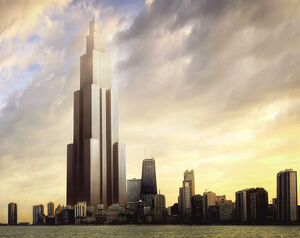
The modular skyscrapers built in Kannin were actually designed in the Chinese Imperial Union
Kannin is a Sassanid Persian city in to the north-west of the Indian subcontinent. It was one of the first urbanates (planned cities) to be built by National Control after Persia completed its transition to a technocracy in AD1936.
History[]
Prior to it's construction, the area around Kannin was under Old Persian control, and in 1329, came under Greek control, before being left by Greece in 1379 after Greece and Rome signed a peace treaty requiring Greece to leave Persia and Rome. Construction of Kannin itself began in AD1938 after extensive planning. The city would be built upstream of the River Indus in a good farming area, though the discovery of a small oil deposit in the area may also have contributed to the decision.
There was a lot of debate over the design of the city. Some thought that the city should be built as efficiently as possible, separated into districts that each specialised in performing different tasks for the city. Others said that this design would result in delocalisation and longer travel times, proposing the less efficient design of a modular urbanate split into small, autonomous districts. It is usually thought that a combination of both was used, but historians and architects alike agree than the specialised, more efficient design is predominant in the city.
In 2013, the city experienced terrorist attacks, causing humanitarians from both the Quadruple Alliance and Greco-Indian-Inuit Alliance to arrive in the city to assist.
Design[]
Kannin is built in a grid system of wide streets, though cars as a form of personal transport are banned (the government is allowed to use them, though). Each street has a wide canal running down the middle for goods transport and a monorail running above for personal transport.
Buildings are constructed in a modular fashion; individual modules are made on production lines then put together on site. Some of these buildings are tall skyscrapes, though most are only a few stories high; most of the population lives in flats. Because of the modular design of the buildings the architecture in Kannin is very angular and metallic; people have tried to alleviate this problem by planting foliage on balconies and hanging up bright coloured banners. For this reason, despite the skyline of the city seeming very cold and industrial, the streets themselves are rather pleasant and parklike.
Despite much political argument over the subject, Kannin was partitioned by walls and fences in AD1954. Usually the gates are opened and these barriers are not even noticable, but in the event of an invasion, a criminal on the loose or a disease (requiring quarantine), parts of the city can be made innavigable.
Districts[]
It is hard to stay in one part of the city for long. For example, if you were in the residential district you would eventually have to go to the reatil district to buy food, the industrial district to work or the recreation district for stimulation. Flats in Kannin are small and the government encourages people to "outsource their lives;" people are encoraged to eat in canteens and go to a public cinema rather than eat meals and watch television at home.
